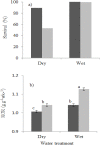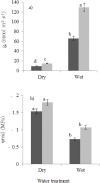The effects of drought and shade on the performance, morphology and physiology of Ghanaian tree species
- PMID: 25836337
- PMCID: PMC4383566
- DOI: 10.1371/journal.pone.0121004
The effects of drought and shade on the performance, morphology and physiology of Ghanaian tree species
Abstract
In tropical forests light and water availability are the most important factors for seedling growth and survival but an increasing frequency of drought may affect tree regeneration. One central question is whether drought and shade have interactive effects on seedling growth and survival. Here, we present results of a greenhouse experiment, in which seedlings of 10 Ghanaian tree species were exposed to combinations of strong seasonal drought (continuous watering versus withholding water for nine weeks) and shade (5% irradiance versus 20% irradiance). We evaluated the effects of drought and shade on seedling survival and growth and plasticity of 11 underlying traits related to biomass allocation, morphology and physiology. Seedling survival under dry conditions was higher in shade than in high light, thus providing support for the "facilitation hypothesis" that shade enhances plant performance through improved microclimatic conditions, and rejecting the trade-off hypothesis that drought should have stronger impact in shade because of reduced root investment. Shaded plants had low biomass fraction in roots, in line with the trade-off hypothesis, but they compensated for this with a higher specific root length (i.e., root length per unit root mass), resulting in a similar root length per plant mass and, hence, similar water uptake capacity as high-light plants. The majority (60%) of traits studied responded independently to drought and shade, indicating that within species shade- and drought tolerances are not in trade-off, but largely uncoupled. When individual species responses were analysed, then for most of the traits only one to three species showed significant interactive effects between drought and shade. The uncoupled response of most species to drought and shade should provide ample opportunity for niche differentiation and species coexistence under a range of water and light conditions. Overall our greenhouse results suggest that, in the absence of root competition shaded tropical forest tree seedlings may be able to survive prolonged drought.
Conflict of interest statement
Figures




References
-
- Schiøtz M, Boesen M, Nabe-Nielsen J, Sørensen M, Kollmann J (2006) Regeneration in Terminalia oblonga (Combretaceae)—A common timber tree from a humid tropical forest (La Chonta, Bolivia). Forest ecology and management 225: 306–312.
-
- Marod D, Kutintara U, Tanaka H, Nakashizuka T (2002) The effects of drought and fire on seed and seedling dynamics in a tropical seasonal forest in Thailand. Plant Ecology 161: 41–57.
-
- Duclos V, Boudreau S, Chapman CA (2013) Shrub Cover Influence on Seedling Growth and Survival Following Logging of a Tropical Forest. Biotropica 45: 419–426.
-
- Valladares F (2003) Light heterogeneity and plants: from ecophysiology to species coexistence and biodiversity Progress in Botany: Springer; pp. 439–471.
-
- Nepstad D, Lefebvre P, Lopes da Silva U, Tomasella J, Schlesinger P, Solorzano L, et al. (2004) Amazon drought and its implications for forest flammability and tree growth: A basin‐wide analysis. Global Change Biology 10: 704–717.
Publication types
MeSH terms
Substances
LinkOut - more resources
Full Text Sources
Other Literature Sources

